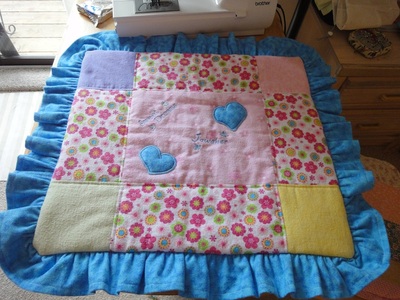HI
i have some old quilts that have been thoroughly used, and there are a few seams that have pulled apart. it got me wondering why quilt seams are not serged?I had a beautiful quilted bag that fell apart because the maker used 1/4 inch seams when a 1/2 inch seam and overlocking would have been wiser. The fabric was a very lose weave, not at all like I would use to make a quilt.
I do crazy patchwork, so there is embroidery, hand or machine, over my seams. I do not like my things to come apart. :-)
{Confessions of a control freak}
you can use a Serger to make a quilt but the reason why we don't (as far as I know) is it adds extra bulk on the seams where we don't want it. I agree with Dolly going over the seams is always a wise choice & I am doing that on the one I have loaded on my frame as I type. A tough job lol ~hugs~
Having seen many quilts with open and frayed seams I have always always done my quilts from day 1 with top stitching nest to the seam and will never worry about the seams opening!! It may not look so great but from a distance you can't notice it!
1 comment
This is a good idea. I did this type of quilting on a zig zag quilt a while back. I like the look of it and it makes it more secure too. I think it is called echo quilting isnt it?
You and me both, Undecided.
I am an old school dressmaker, strictly 5/8" seams, so 1/4" seams with unfinished, raw edges always irked me, until I made a couple of quilts and realised the importance of accuracy in all those little pieces when joining them altogether.
Still...... making the first one, (without overlocking) made me squirm inside! LOL!!!
1 comment
This made me laugh. I went to quilting classes just so i could unlearn my dressmaking skills and learn quilting and patchwork the proper way!
probably just tradition. Early quilts were all done with just the needle and thread (by Amish ladies). Nothing to stop you trying, but it may not be really really perfect at the joins.
I agree with what has been said too and overlocker thread is usually polycotton so not ideal to use when making a cotton quilt as it behaves differently to cotton thread. Also using the overlocker uses up a larger quantity of thread so it becomes an added cost.
that being said I have used my overlocker to make quilted picnic rugs and other patchwork items when the fabric has been washed9recylcled clothing) or made from a mix of fabrics. It gives added strength and the extra bulk in the seams on these projects doesn't matter so much.
If they are 'old' they could have been made before sergers were available as a household machine
1 comment
And if they were new in the 80's or 90's and inexpensive, they may have come out of China, hand work, but poorly and swiftly done and labor cheaper than machinery.
I would agree with both answers below. One is the 1/4 inch seam allowance. Not that easy to get right on a serger. The other is the bulk when you go to quilt the top and layers together. There are a few designs made for sergers that are quilted as the seams are serged.
Bulky seams would be my guess...when piecing a block, can you imaging how much bulk there would be with say, eight points coming together...also, if you were quilting and ran into intersecting serged seams it could be pretty thick...that said...other than the thickness, I would say in certain instances for certain uses why not?
1 comment
I have used my overlocker on occasion. As I only make quilts with cotton fabric it doesn't matter if the seams are a bit thicker with them being overlocked (where the pieces join). I would imagine if thicker fabrics were used you would have an issue with the seams laying flat. With modern machines these days you get markings showing 1/4 inch seams etc. which is the norm seam allowance. I've never had any of my quilts come undone at the seams as I make sure they are all even. But then again mine are all machine made!!! Love ❤️ Chris







